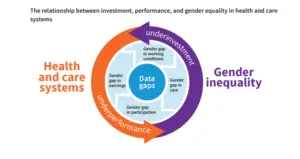
Why in news?
- The release of the World Health Organization’s (WHO) “Fair Share for Health and Care” report sheds light on the pervasive gender disparities within the global healthcare sector.
- From underrepresentation in leadership roles to chronic underinvestment, the report underscores the urgent need for comprehensive action to address these issues.
Gender Disparities in Health and Care Workforce:
- The report reveals stark gender disparities within the healthcare workforce, with women comprising 67% of paid global health and care workers.
- Despite their significant contribution, women are often relegated to lower-status roles and underrepresented in leadership positions.
- This imbalance not only perpetuates economic inequality but also hampers progress towards gender equality.
Chronic Underinvestment and Devaluation of Caregiving:
- Chronic underinvestment in health and care work perpetuates a vicious cycle of unpaid care work, hindering women’s participation in the labor market and impeding economic empowerment.
- Caregiving, primarily undertaken by women, is often undervalued, leading to lower wages and poor working conditions.
- This devaluation not only impacts the economic viability of the sector but also perpetuates gender-based disparities in healthcare.
Implications and Recommendations:
- The report underscores the far-reaching implications of gender disparities in healthcare, from limited investment in family and community well-being to higher levels of gender-based violence.
- To address these challenges, the report offers key recommendations, including improving working conditions, enhancing wage equality, and investing in robust public health systems.
Government Initiatives to Address Gender Disparity:
- Governments worldwide have initiated various programs and policies to tackle gender disparity in healthcare.
- From economic empowerment schemes like Beti Bachao Beti Padhao to initiatives promoting female entrepreneurship, these efforts aim to empower women and promote gender equality in healthcare.
Conclusion:
- The “Fair Share for Health and Care” report serves as a wake-up call to address the systemic gender disparities within the healthcare sector.
- By implementing comprehensive measures outlined in the report and bolstering government initiatives, we can work towards a more equitable and inclusive healthcare system for all.
- It’s imperative that we prioritize gender equality in healthcare to ensure a healthier and more prosperous future for generations to come.
People also ask
Q1: What causes chronic underinvestment in health and care work?
Ans: Chronic underinvestment often stems from societal undervaluation of caregiving roles, particularly those primarily undertaken by women. This leads to lower wages and poor working conditions in the healthcare sector.
Q2: How does chronic underinvestment impact women’s participation in the labor market?
Ans: Chronic underinvestment perpetuates a cycle of unpaid care work, which disproportionately burdens women and hinders their ability to participate fully in the labor market, thereby impeding their economic empowerment.
Q3: What are the consequences of devaluing caregiving in healthcare?
Ans: Devaluing caregiving work results in lower wages and poor working conditions for healthcare workers, especially women. This not only impacts the economic viability of the sector but also perpetuates gender-based disparities in healthcare.
Q4: How do gender disparities in healthcare affect family and community well-being?
Ans: Gender disparities in healthcare lead to limited investment in family and community well-being, as caregiving responsibilities often fall disproportionately on women. This can have adverse effects on overall health outcomes and quality of life.